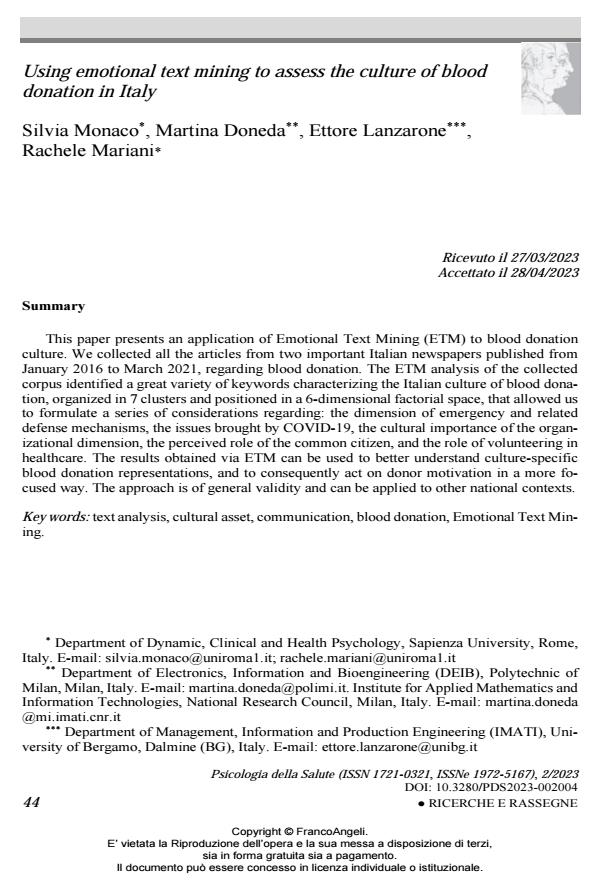Using emotional text mining to assess the culture of blood donation in Italy
Titolo Rivista PSICOLOGIA DELLA SALUTE
Autori/Curatori Silvia Monaco, Martina Doneda, Ettore Lanzarone, Rachele Mariani
Anno di pubblicazione 2023 Fascicolo 2023/2
Lingua Inglese Numero pagine 23 P. 44-66 Dimensione file 320 KB
DOI 10.3280/PDS2023-002004
Il DOI è il codice a barre della proprietà intellettuale: per saperne di più
clicca qui
Qui sotto puoi vedere in anteprima la prima pagina di questo articolo.
Se questo articolo ti interessa, lo puoi acquistare (e scaricare in formato pdf) seguendo le facili indicazioni per acquistare il download credit. Acquista Download Credits per scaricare questo Articolo in formato PDF

FrancoAngeli è membro della Publishers International Linking Association, Inc (PILA)associazione indipendente e non profit per facilitare (attraverso i servizi tecnologici implementati da CrossRef.org) l’accesso degli studiosi ai contenuti digitali nelle pubblicazioni professionali e scientifiche
This paper presents an application of Emotional Text Mining (ETM) to blood donation culture. We collected all the articles from two important Italian newspapers published from January 2016 to March 2021, regarding blood donation. The ETM analysis of the collected corpus identified a great variety of keywords characterizing the Italian culture of blood dona-tion, organized in 7 clusters and positioned in a 6-dimensional factorial space, that allowed us to formulate a series of considerations regarding: the dimension of emergency and related de-fense mechanisms, the issues brought by COVID-19, the cultural importance of the organizational dimension, the perceived role of the common citizen, and the role of volunteering in healthcare. The results obtained via ETM can be used to better understand culture-specific blood donation representations, and to consequently act on donor motivation in a more fo-cused way. The approach is of general validity and can be applied to other national contexts.
Questo lavoro presenta un’applicazione di Emotional Text Mining (ETM) al contesto della donazione di sangue. Abbiamo raccolto tutti gli articoli, pubblicati da Gennaio 2016 a Marzo 2021, dei due più importanti quotidiani italiani trattanti il tema della donazione di sangue. L’analisi ETM del corpus così raccolto ha identificato una grande varietà di parole chiave che caratterizzano la cultura italiana della donazione del sangue, organizzata in 7 cluster posizionati in uno spazio fattoriale 6-dimensionale, che ci ha consentito di formulare una serie di conside-razioni concernenti: la dimensione dell’emergenza e i relativi meccanismi di difesa, le proble-matiche portate dalla pandemia di COVID-19, l’importanza culturale della dimensione orga-nizzativa del sistema, e, infine, il ruolo percepito del cittadino comune e quello delle organizza-zioni di volontariato in sanità. I risultati ottenuti con l’analisi ETM possono essere utilizzati per meglio comprendere le rappresentazioni della donazione di sangue specifiche del contesto analizzato, e conseguentemente agire sul coinvolgimento dei donatori in maniera più focalizzata. L’approccio ha una validità generale e può essere utilizzato in altri contesti nazionali.
Parole chiave:analisi del testo, asset culturali, comunicazione, donazione del sangue, Emotio-nal Text Mining.
Silvia Monaco, Martina Doneda, Ettore Lanzarone, Rachele Mariani, Using emotional text mining to assess the culture of blood donation in Italy in "PSICOLOGIA DELLA SALUTE" 2/2023, pp 44-66, DOI: 10.3280/PDS2023-002004